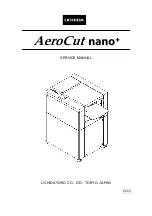
•
If the pressure drops, the leak
must be located and the faulty
part replaced.
Note: To locate the leak, coat the
suspect area with oil and pressuri-
ze the crankcase again. Bubbles
will appear at the oil-coated area if
a leak exists.
- Then carry out vacuum test,
- Open vent screw and disconnect
hose when test is complete.
- Remove test flange.
- Loosen the muffler screws.
- Draw out the sealing plate and
tighten the muffler screws with
9.5 Nm.
- Fit outer screw of muffler and
tighten with 9.5 Nm.
- Install carburetor,
Oil seals tend to fail when sub-
jected to a vacuum, i.e. the sealing
lip lifts away from the crankshaft
during the piston’s induction stroke
because there is no internal coun-
terpressure.
Faults of this kind can be detected
with the aid of a vacuum pump.
The preparations are the same as
for the pressure test,
•
Connect suction hose of vacuum
pump 0000 850 3501 to nipple of
test flange.
•
Close vent screw (1) on pump
cylinder.
•
Actuate lever (2) until pressure
gauge (3) indicates a vacuum of
0.5 bar.
Note: The oil seals are in good
condition if the indicated vacuum
is maintained or if the pressure
rises to no more than 0.3 bar
within 20 seconds.
The oil seals must be replaced if
the pressure in the crankcase con-
tinues to rise.
- Open vent screw and disconnect
hose when test is complete.
- Remove test flange.
- Loosen muffler screws.
- Remove sealing plate and
tighten screws to a torque of 9.5
Nm.
- Fit outer screw in muffler and
tighten to a torque of 9.5 Nm.
- Install carburetor,
392RA021 VA
392RA020 VA
3
3
1
1 2
2
392RA022 VA
13














































